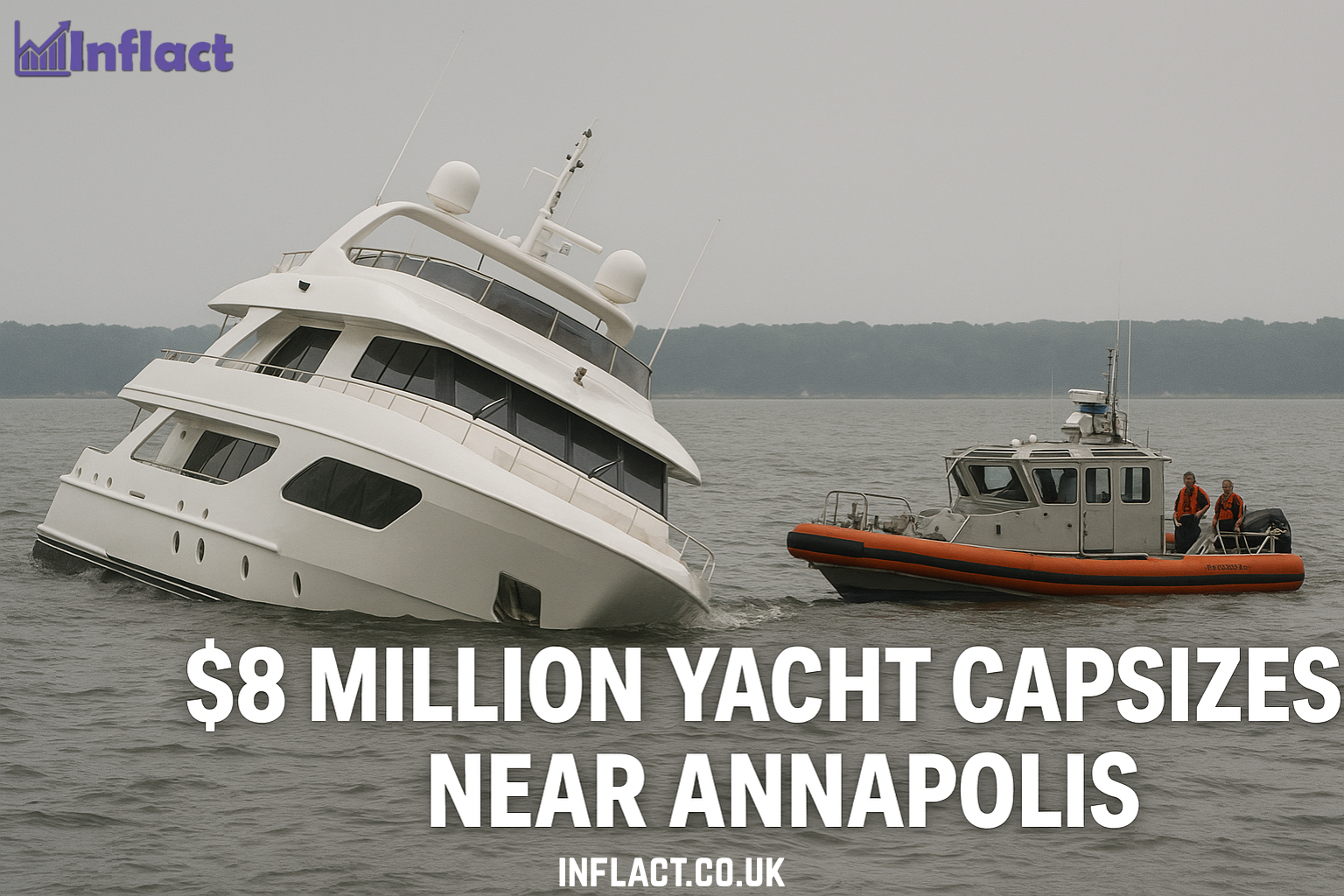Introduction
On a calm summer afternoon near Annapolis, Maryland, a seemingly routine cruise turned into a high-stakes rescue mission when a luxury yacht valued at $8 million unexpectedly capsized in the Chesapeake Bay. The vessel, known as Lovebug, was a 122-foot Italian-built superyacht that represented both prestige and elegance—until it tipped perilously off the West River’s mouth in July 2024.
This shocking event has captured the attention of boaters, maritime safety experts, and the public alike. In this article, we break down what happened during the incident, what may have caused the capsize, how the rescue unfolded, and what lessons it offers for yacht owners and seafarers. The story serves as a wake-up call about the unpredictable nature of maritime travel—even aboard vessels worth millions.
Incident Overview: Where, When, and What Happened
The capsizing occurred on July 27, 2024, just after 12:30 p.m., about eight nautical miles south of Annapolis, near the mouth of the West River in the Chesapeake Bay. The yacht, Lovebug, began taking on water under unexplained circumstances and quickly developed a severe list to the starboard side.
Key Facts:
- Vessel: 122-foot yacht named Lovebug
- Estimated value: $8 million
- Location: Chesapeake Bay, near Annapolis, Maryland
- Occupants: 5 people (including crew and passengers)
- Casualties: None; all rescued safely
Though the water was relatively calm, witnesses reported that the yacht leaned steeply before partially capsizing, prompting an immediate emergency response.
Also Read: Ground News Review: A Transparent Approach to Media Bias and News Aggregation
Rescue Operation and Response Teams
The situation escalated quickly, prompting a multi-agency response. Within minutes of distress signals, the U.S. Coast Guard and the Maryland Department of Natural Resources Police arrived at the scene. A coordinated rescue mission was launched to save the five people onboard.
Emergency Response Breakdown:
- Coast Guard deployed a 29-foot response boat from nearby Station Annapolis.
- Maryland Natural Resources Police provided water containment and environmental safety support.
- All occupants were safely evacuated with no injuries reported.
Containment booms were also placed around the vessel as a precaution to prevent environmental contamination from fuel or oil leaks—an increasingly important step in yacht incident response.
Yacht Details: The Story of Lovebug
Lovebug is no ordinary vessel. Formerly known as Anastasia M, the yacht was an Italian-made superyacht outfitted with top-tier luxury features, including spacious decks, entertainment systems, and high-end suites. It had been available for charter at $125,000 per week, making it a symbol of wealth and exclusivity in the world of private maritime travel.
Its luxurious design makes the incident all the more surprising and troubling—raising questions about how even such well-equipped yachts can experience catastrophic failures.
Investigation: What Could Have Caused the Capsize?
While the official cause of the incident remains under investigation, preliminary information suggests that Lovebug began taking on water without grounding or collision. This could point to:
- Hull breach or valve failure
- Mechanical failure in bilge pumping systems
- Stability issues due to load distribution
- Structural fatigue
Witnesses noted that there were no weather disturbances or high waves at the time, which likely rules out natural causes like rough seas or wind-related imbalance.
Step-by-Step Overview of Potential Failure:
- Initial leak or breach occurs below deck.
- Bilge pumps may have been overwhelmed or failed.
- Water collects on one side of the yacht, causing it to list.
- Listing worsens, making the vessel unsalvageable without external intervention.
- Emergency teams respond and secure vessel and occupants.
Pro tip for yacht owners: Regular maintenance checks of through-hull fittings, pumps, and ballast distribution can greatly reduce risk of flooding incidents.
Environmental and Financial Implications
Though the vessel did not sink completely, the damage is estimated to be millions in recovery and repairs. Salvage operations are currently underway, but lifting and towing a partially submerged superyacht is a complex and costly procedure.
Environmental Concerns:
- Potential diesel or oil spills
- Damage to marine habitats
- Long-term impact on Chesapeake Bay ecosystem
Fortunately, swift placement of containment booms prevented visible pollution, but authorities will monitor the site for lingering effects.
Also Read: Unpacking the Augusta Precious Metals Lawsuit: Facts, Myths, and Investor Guidance
Conclusion
The $8 million yacht capsizes near Annapolis story is more than a viral headline—it’s a cautionary tale for anyone involved in marine travel or ownership. Despite the value, prestige, and engineering behind yachts like Lovebug, accidents can and do happen without warning.
Thanks to quick action from the Coast Guard and local authorities, no lives were lost. Still, the event underscores the importance of preventive maintenance, emergency preparedness, and environmental caution when navigating large vessels.
Frequently Asked Questions (FAQs)
1. What caused the $8 million yacht to capsize near Annapolis?
The exact cause is still under investigation, but the yacht reportedly began taking on water without grounding, suggesting a possible mechanical or structural failure.
2. Were there any injuries in the incident?
No. All five individuals onboard were safely rescued, and no serious injuries were reported.
3. Was there any environmental damage from the yacht capsizing?
Containment booms were deployed quickly to minimize the risk of fuel or oil spills, and no major environmental damage has been reported so far.
4. Who responded to the emergency?
The U.S. Coast Guard and Maryland Natural Resources Police led the rescue and containment efforts, ensuring a safe and rapid response.
5. Is the yacht recoverable, or is it a total loss?
Salvage efforts are underway. While it’s unclear whether the vessel is a total loss, the recovery process will be extensive and costly.




